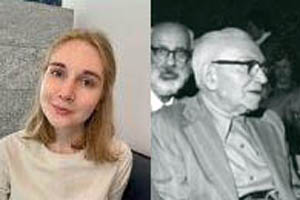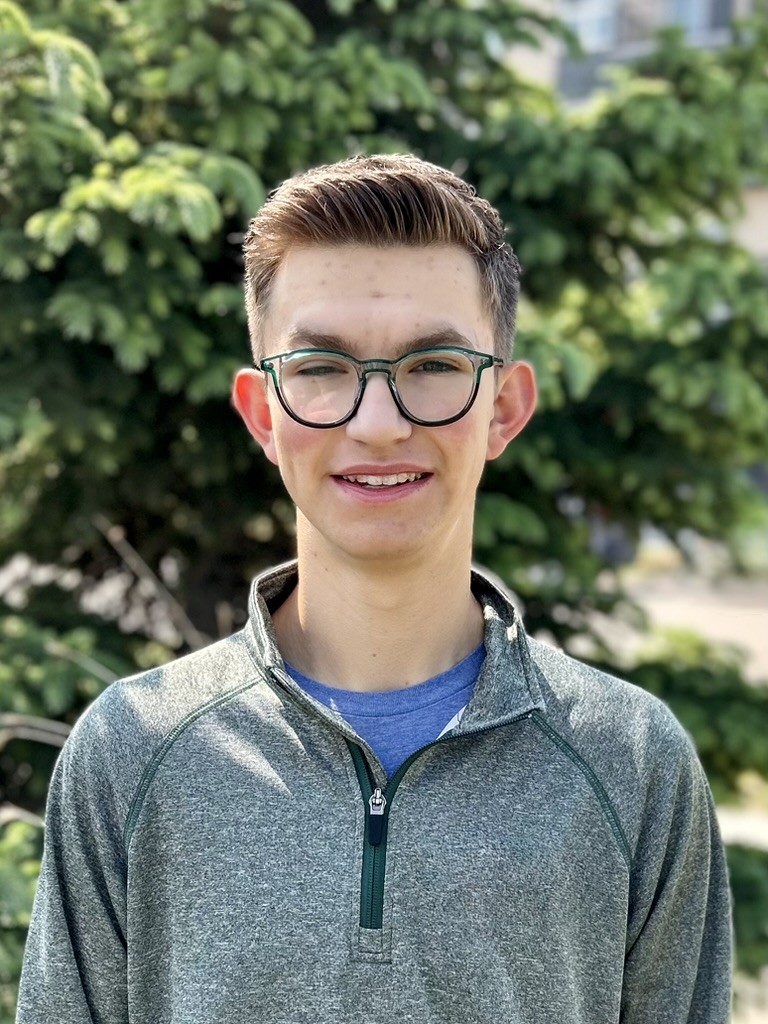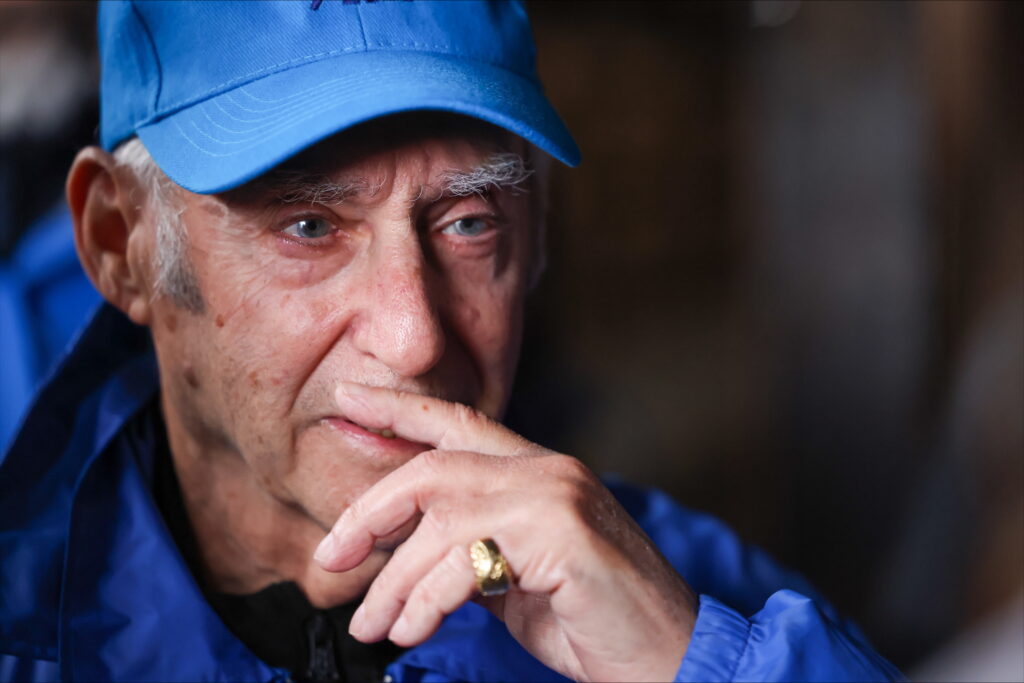Local News
Jewish Heritage Centre to present talk on Western Canadian Jewish anarchists, including Feivel Simkin

By BERNIE BELLAN Maria Tarasova-Chomard is a young (24 year old) student, originally from Russia, now living in Paris, who will be presenting a talk on Western Canadian Jewish anarchists for the Jewish Heritage Centre of Western Canada on Sunday, October 3rd.
In the September 1st article I noted that I would have more about my interview with Maria in our September 15 issue, including some detailed information about certain Jewish individuals who were leading anarchists in Winnipeg in the early part of the 20th century.
I should also note that Maria is the first student winner of the Switzer-Cooperstock prize, given for an original essay on a subject relating to Western Canadian Jewish history. The Switzer-Cooperstock prize is awarded biennially, with the new student prize awarded in alternate years.
Returning to my conversation with Maria, which occurred over Zoom on August 24 while Maria was in her Paris home, I asked her “whether there were any names of well-known Jewish anarchists from Western Canada that” she could “throw out for the benefit of readers”?
Maria responded: “Yes, there were the Prasow brothers – Zalman and Israel – they were the leaders of the movement actually. Then there was Feivel (Frank) Simkin.”
Saying the name “Feivel Simkin” certainly triggered a greater interest on my part, since the Simkin name is so well known within the Jewish community. While I don’t want to preempt anything Maria might have to say during her talk on October 3rd, I’m sure reading the name “Simkin”, followed by the word “anarchist” might come as a bit of a surprise to at least some readers.
Following my conversation with Maria, I sent an email to Stan Carbone, curator of the Jewish Heritage Centre, in which I noted that Maria had said that Feivel Simkin was a leading anarchist in Winnipeg – which came as a surprise to me. I had known that Feivel Simkin had been the publisher of the Israelite Press, but beyond that, I knew nothing about the man.
So, Stan sent me a transcript of an interview that Roz Usiskin had conducted with Feivel Simkin in 1977, in which he tells his life story – also how he defines “anarchism”. Here is what he said at one point in the interview: “They believed that you should educate yourself, and then you didn’t need government to look after you.”
I said to Maria that I’d always been a little unclear how to define “anarchist”. I said to her that I thought the anarchist movement had begun in the late 19th century, but she said it actually began earlier than that – “in the beginning of the 19th century”, but the “period of the flourishing of the movement was really toward the end of the century”.
I asked Maria to give me “a Cole’s Notes definition of ‘anarchism’”.
Maria answered: “The most important aspect is that it’s a movement that believes in a society based on community, based on unity, and denies constraint and privilege.”
I asked: “But doesn’t it reject most forms of government authority?”
Maria responded: “Yes, but that comes from a rejection of constraint and privilege. Every state, every government (according to anarchists) is based on constraint and privilege – and hierarchy.”
As our conversation continued, I asked Maria how easy is it to actually identify individuals in the early 20th century in Winnipeg as “anarchists”?
She said it is difficult to do because “there are very few records and since the movement was essentially clandestine, they were actually paying attention not to keep evidence as to who was an anarchist, but when I talk about the ‘anarchist’ movement’ in my work, I talk not only about those who were directly involved in the organizations and activities of the organizations, but also everyone who was interested in the ideas – who called themselves radicals or libertarians.
“We can distinguish two circles. There was the core – the actual activists, the organizers – and there were those who participated in events, were sort of around”, but who couldn’t necessarily be described as ‘anarchists’.”
I asked what documentation might have existed that would have led Maria to conclude that the Prasow brothers and Feivel Simkin were the leaders of the anarchist movement?
Maria said it was mostly through “correspondence” among those three figures, especially correspondence between the Prasows and the leading American anarchist at the time, Emma Goldman (who actually stayed with the Prasows in their house at one time when she visited Winnipeg, Maria noted).
I wondered though, whether that correspondence would have been conducted in English or Yiddish – since Yiddish would have been the mother tongue of those early 20th century anarchists.
Maria explained that English was the preferred language of the anarchists, especially since Emma Goldman had insisted that anarchists’ writing be in English, so that it would be understood by “the generation born in America”.
As a result of this emphasis on the next generation, “a lot of their effort went into education,” Maria said.
Given the anarchists’ objection to governmental authority, I wondered whether there was a convergence between anarchism and the kibbutz movement, for instance, which was also predicted on a rejection of authority?
Maria suggested though that there was a fundamental divide between anarchism and Zionism. For anarchists, “the nation should either not exist or should only exist until there are not any nations at all. The Zionist movement (in contrast) was about Jewish nationalism. For anarchists, building the nation or an ethnic movement was not important at all.”
But, just how many identifiable anarchists were there in Winnipeg in the early part of the 20th century, I wondered? “Would they have been in the hundreds?” I asked Maria.
“Oh no,” she answered. “I’ve been able to identify only five or six of them.” (And yet, in Roz Usiskin’s interview with Feivel Simkin, he referred to Emma Goldman filling a hall with 700 attendees when she spoke in Winnipeg, so surely that must have been more than a passing interest in anarchy among a great many Winnipeg Jews in the early 20th century.)
Still, as Maria pointed out, “they may have been people who were simply interested in going to a talk.”
Was anarchism more than a “fringe movement” then? I asked.
“Oh yes,” Maria responded. “They were noticeable in the ideological landscape of the time, especially before (the Winnipeg General) Strike, in 1919. They were bringing about real change in the sense that their influence, their contribution to real projects, to social education was pretty noticeable –and pretty impressive, for the time. It wasn’t just a marginal group, even though it was a lot less numerous than some of the other currents.”
During our entire conversation, the discussion was confined to Jewish anarchists. I wondered, however, whether Maria had come across any references to non-Jewish anarchists during that period in the early 20th century?
“It’s not something I have found a lot of mention about,” Maria answered. “I know there was quite a lot of cooperation in the United States between Jewish and Italian anarchists – and with Spanish anarchists toward the 1930s, and with German groups” as well, “but in Canada it’s truly hard to say (whether there was much involvement by non-Jews in the anarchist movement). “I have not been able to find any mention of that.”
Local News
Further to the Simkin Centre’s financial situation

By BERNIE BELLAN A while back I published an article about the deficit situation at the Simkin Centre. (You can read it at “Simkin Centre deficit situation.“) I was prompted to write that particular article after reading a piece written by Free Press Faith writer John Longhurst in the August 5 issue of the Free Press about the dire situation personal care homes in Winnipeg are in when it comes to trying to provide their residents with decent food.
Yet, Longhurst made one very serious mistake in his article when he wrote that the “provincial government, through the Winnipeg Regional Health Authority, has not increased the amount of funding it provides for care-home residents in Manitoba since 2009.”
In fact, the WRHA has given annual increases to personal care homes, but its allocations are not broken down by categories, such as food or salaries. As a spokesperson for the WRHA explained to me in an email: “PCHs receive per diem global operating funding based on the number of licensed beds they operate. This funding model is designed to support the full range of operating costs associated with resident care, including staffing, food services, utilities, building operations, and other day-to-day expenses.”
Now, one can make a perfectly valid argument that the level of funding from the WRHA has not kept up with inflation, especially inflation in food costs, but the Simkin Centre is in an even more precarious position because of the skyrocketing cost of kosher food.
“In recent years,” according to an article on the internet, “the cost of kosher food has increased significantly, often outpacing general food inflation due to unique supply chain pressures and specialized production requirements.”
Yet, when I asked Laurie Cerqueti how much maintaining a kosher facility has cost the Simkin Centre, as I noted in my previous article about the deficit situation at Simkin, she responded: “approximately $300,000 of our deficit was due to food services. I do not have a specific number as far as how much of the deficit is a result of kosher food…So really this is not a kosher food issue as much is it is an inflation and funding issue.”
One reader, however, after having read my article about the deficit situation at Simkin, had this to say: “In John Longhurst’s article on Aug 5, 2025 in the Free Press, Laurie (Cerqueti) was quoted as saying that the annual kosher meal costs at Simkin were $6070 per resident. At Bethania nursing home in 2023, the non-kosher meal costs in 2023 were quoted as $4056 per resident per year. Even allowing for a 15% increase for inflation over 2 years, the non-kosher food costs there would be $4664.40 or 24% lower than Simkin’s annual current kosher food costs. If Simkin served non-kosher food to 150 of its 200 residents and kosher food to half of its Jewish residents who wish to keep kosher, by my calculation it would save approximately $200,000/year. If all of Simkin’s Jewish residents wished to keep kosher, the annual savings would be slightly less at $141,000.”
But – let’s be honest: Even though many Jewish nursing homes in the US have adopted exactly that model of food service – where kosher food is available to those residents who would want it, otherwise the food served would be nonkosher, it appears that keeping Simkin kosher – even though 45% of its residents aren’t even Jewish – is a “sacred cow” (pun intended.)
So, if Simkin must remain kosher – even though maintaining it as a kosher facility is only adding to its accumulated deficit situation – which currently stands at $779,426 as of March 31, 2025,I wondered whether there were some other ways Simkin could address its deficit while still remaining kosher.
In response to my asking her how Simkin proposes to deal with its deficit situation, Laurie Cerqueti wrote: “There are other homes in worse financial position than us. There are 2 homes I am aware of that are in the process of handing over the keys to the WRHA as they are no longer financially sustainable.”
I wondered though, whether the Simkin Centre Foundation, which is managed by the Jewish Foundation of Manitoba might not be able to help the Simkin Centre reduce its deficit. According to the Jewish Foundation’s 2024 annual report, The Saul and Claribel Simkin Centre Foundation, which is managed by the Jewish Foundation, had a total value of $11,017,635.
The Jewish Foundation did distribute $565,078 to the Simkin Centre in 2024, but even so, I wondered whether it might be able to distribute more.
According to John Diamond, CEO of the Jewish Foundation, however, the bylaws of the Foundation dictate that no more than 5% of the value of a particular fund be distributed in any one year. There is one distinguishing characteristic about the Saul and Claribel Simkin Centre Foundation, in that a portion of their fund is “encroachable.” The encroachable capital is not owned by JFM. It is held in trust by JFM but is beneficially owned by Simkin, similar to a “bank deposit”. While held by the JFM, these funds are included in the calculation of Simkin’s annual distribution.
I asked John Diamond whether any consideration had been given to increasing the distribution that the Jewish Foundation could make to the Simkin Centre above the 5% limit that would normally apply to a particular fund under the Foundation’s management.
Here is what John wrote in response: “The Simkin does have an encroachable fund. That means that at their request, they can encroach on the capital of that fund only (with restrictions). This encroachment is not an increased distribution; rather, it represents a return of capital that also negatively affects the endowment’s future distributions.
”It is strongly recommended that encroachable funds not be used for operating expenses. If you encroach and spend the capital, the organization will receive fewer distribution dollars in the next year and every year as the capital base erodes. Therefore, the intent of encroachable funds is for capital projects, not recurring expenses.”
I asked Laurie Cerqueti whether there might be some consideration given to asking for an “encroachment” into the capital within the Saul and Claribel Simkin Centre Foundation?
She responded: “We are not in a position where we are needing to dip into the encroachable part of our endowment fund. Both of our Boards (the Simkin Centre board and the Saul and Claribel Simkin Centre Foundation board) are aware of our financial situation and we are all working together to move forward in a sustainable way.”
At the same time though, I wondered where donations to the Simkin Centre end up? Do they all end up in the Simkin Centre Foundation, for instance, I asked Laurie Cerqueti on December 15.
Her response back then was: “All donations go through our Foundation.”
I was somewhat surprised to read that answer, so I asked a follow-up question for clarification: “Do all donations made to the Simkin Centre end up in the Simkin Centre Foundation at the Jewish Foundation?”
The response this time was: “No they do not.”
So, I asked: “So, how do you decide which donations end up at the Foundation? Is there a formula?”
Laurie’s response was: “We have a mechanism in place for this and it is an internal matter.”
Finally, I asked how then, the Simkin Centre was financing its accumulated deficit? Was it through a “line of credit with a bank?” I wondered.
To date, I have yet to receive a response to that question. I admit that I am puzzled that a personal care home which has a sizeable foundation supporting it would not want to dip into the capital of that foundation when it is facing a financial predicament. Yes, I can see wanting the value of the foundation to grow – but that’s for the future. I don’t know whether I’d call a $779,425 deficit a crisis; that’s for others to determine, but it seems pretty serious to me.
One area that I didn’t even touch upon in this article, though – and it’s something I’ve written about time and time again, is the quality of the food at the Simkin Centre.
To end this, I’ll refer to a quote Laurie Cerqueti gave to John Longhurst when he wrote his article about the problems personal care homes in Winnipeg are facing: “When it comes to her food budget, ‘we can’t keep making the same number of bricks with less straw.’ “
Local News
Exclusive: Security Enhancement Fund to be announced by Province in coming days

By NOAH STRAUSS The province is set to announce a new program called the Security Enhancement Fund, which
will provide funding to religious and faith groups to improve security at institutions such as
synagogues and mosques. In an exclusive interview, Minister of Justice Matt Wiebe outlined the
plan and detailed what the province has already done to help protect Jewish Manitobans.
“What we want to do is to be able to provide the community with the kind of tools that they need
to stay safe and to ensure that everyone in the community feels safe,” said Wiebe.
The fund will provide a missing link between government and religious communities, and
communities will now be able to make their own choices without money being a big restraint.
Essentially, the power will be in the hands of community leaders and not government officials.
The minister noted that the new partnerships will provide the province a better understanding of
the needs of every community. Rather than the province making the choices, they are
essentially giving a voice to each community. The grants, totalling $1 million, will provide funds to enhance security at facilities like synagogues.
The Jewish Post reached out to Dr. Rena Secter Elbaze, executive director of Congregation
Shaarey Zedek. “It’s important that the government show us that they’re taking security seriously and stepping up to the plate to make this offer. We will absolutely be applying for grant money,” she said. Elbaze also wants to know whether or not the government will cover the costs of things the synagogue has already spent money on. She noted that the province has, in the past, made grants available to have security guards present.
When speaking about what the Justice Ministry has already done to protect Jewish Manitobans,
Wiebe brought up the new special prosecutor that is focusing on hate crimes. Wiebe said the
special prosecutor works closely with the Winnipeg Police Service “to support investigations and
prosecute hate crimes. Wiebe also went on to say how the Department of Education has been helping to fight antisemitism. “The creation of the Holocaust education curriculum is an important step in the right direction,” he said. When asked about Oliver Didtger Ederhof, the individual charged with 14 counts of mischief including vandalism of Shaarey Zedek, Wiebe said decisions like bail and police undertakings are decisions that are in part made by the federal government through the criminal code and policies. “We’re going to continue to advocate for stricter bail reform at the federal level…. I’ve been very clear, we issued clarified directives around bail to our Crown prosecutors.”
The full announcement from the province is expected in the coming days.
Local News
March of the Living 2023 participants form Taste of Hope project to help honour the memory of Holocaust survivor Alex Buckman

By BERNIE BELLAN The March of the Living is an annual two-week international educational program that brings thousands of students and adults to Poland and Israel to study the Holocaust, Jewish history, and the rise of the State of Israel. Founded in 1988, it features a 3-kilometer silent walk from Auschwitz to Birkenau on Yom HaShoah (Holocaust Remembrance Day).
Attendees on the march are accompanied by adults, some of whom themselves have been Holocaust survivors.
Following the week in Poland, participants travel to Israel to observe Yom HaZikaron (Israel’s Memorial Day) and celebrate Yom HaAtzmaut (Israel’s Independence Day), marking a journey from darkness to life.
For many years the coordinator of the march in Winnipeg was Roberta Malam, working on behalf of the Jewish Federation of Winnipeg. More recently Abby Flackman filled that role, and now the person in charge is Lindsey Kerr.
Since its inception 37 years ago the March of the Living has become a rite of passage for many young Winnipeg Jews who have been able to participate as an organized group from Winnipeg and combine visits to the death camp at Auschwitz-Birkenau in Poland with the subsequent trip to Israel.
Then – the Covid pandemic hit – in 2020, and the March of the Living was put on hold for two years – in 2020 and 2021.
In 2022, the March of the Living resumed, but there was no organized contingent from Winnipeg participating. (There may have been some Winnipeggers who did go on the march that year, but if there were any they would have been part of a general Canadian group since there was no Winnipeg coordinator that year.)
In 2023, however, once again a very large contingent of young Canadian Jews – 51 altogether, of whom approximately two-thirds were from Winnipeg, went on that year’s March of the Living. That particular march was memorable for many reasons, including the fact it was the last full march since 2019 and was to remain the last march to have an organized Winnipeg contingent in the past six years as the years 2024 and 2025 were interrupted by the war in Gaza. (There were smaller marches held in 2024 and 2025, but again there was no organized contingent from Winnipeg.)
Recently, we were contacted by one of the participants of that 2023 march, Ethan Levene, who asked us whether we’d be interested in running what turned out be a very poignant story about one particular aspect of that 2023 March of the Living.
Here is what Ethan wrote:
“In April 2023, the Coast to Coast Canadian delegation of March of the Living was privileged to travel with Holocaust survivor Alex Buckman (z”l). March of the Living is a Holocaust education trip that allows participants to visit and bear witness to the sites of the Holocaust. Unfortunately, while sharing his story in Poland, Alex passed away. However, the impact he left on us students was immeasurable.

“While speaking to us in Warsaw, Alex told us the story of his Aunt Becky’s gâteau à l’orange (orange cake). While in Ravensbruck concentration camp, his aunt managed to write down this recipe. After his parents’ murder, his Aunt Becky went on to raise Alex after surviving. In addition to sharing his story, Alex tasked us with baking the cake with family and friends.
“Out of this, a group of alumni from our trip have created this project: ‘A Taste of Hope.’ On February 1st, university students from over 5 universities across Canada will come together to bake the gâteau à l’orange and hear Alex’s story. Proceeds from the event and this fundraising page will support the World Federation of Jewish Holocaust Survivors and Descendants. Alex was heavily involved with this organization, whose mission is to both create community for Holocaust survivors and their descendants and educate about the Holocaust to help fight against antisemitism and all forms of bigotry and hate.
“Here is information from our fundraising page for the event – ‘A Taste of Hope’: Fundraising for A Taste of Hope.
Ethan added that “it’s completely student led, all by alumni from our 2023 trip attending university at these various locations across Canada; Winnipeg, London, Kingston, Montreal.”
He also added: “Follow us on instagram@tastehope.“
Here is a link to a CBC story about Alex Buckman: Alex Buckman story
In a subsequent email Ethan gave the names of Winnipeggers who are involved in A Taste of Hope: Ethan Levene (studies at McGill), Zahra Slutchuk, Alex Stoller (studies at Queens), Coby Samphir, Izzy Silver (studies at Waterloo).
He also added names of others who are involved in the project: Jessie Ages, Anneke Goodwin, Lilah Silver, Ella Pertman, Ellie Vogel, and Talia Cherun.
To find out more about March of the Living in Winnipeg go to: March of the Living


